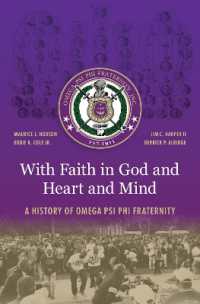- ホーム
- > 洋書
- > 英文書
- > Philosophy
Full Description
Explicitness is one of the fundamental mysteries in which our lives are wrapped. Our capacity, as conscious subjects, to make things explicit, so that what-is presents itself as "that-it-is" or "that-it-is-the-case" is at the heart of the mystery of human being.
Circling Round Explicitness is an endeavour to make explicitness explicit or, at least, more explicit. Its ambition is rooted in the belief that the failure to acknowledge the centrality to our nature as human beings of our capacity to make things explicit explains many false directions in contemporary philosophy, most importantly the embrace of scientism.
With characteristic erudition and acuity across a breathtaking range of subjects, Ray Tallis explores how explicitness connects with fundamental ontological, metaphysical and epistemological questions, including the gap between matter and persons, and between mind and brain, the nature of ourselves as embodied subjects and as agents, the phenomenology of thought, the realm of possibility (and probability) and the ideas of reality and truth.
Although the attempt to grasp explicitness is fraught with challenges - to reach out to that which comprises one's act of reaching - the task is a fascinating endeavour that takes us closer to understanding what it is to be, to be human, and our connection with the material world. In circling round explicitness, we are circling round Man, the Explicit Animal, around ourselves.
Contents
Overture: making explicitness explicit
Part I The unholy trinity
1. Looking in the mirror: a vision of the unholy trinity
1.1 Introducing the unholy trinity
1.2 The blob
1.3 The beast
1.4 The bloke
1.5 Further reflections on being a reflection
2. From things to persons: "emergence" as a non-explanation
2.1 Getting from the thing to the person
2.2 The appeal to emergence
2.3 Emergence from what? "Everything is made of atoms" 1 the evaporation of atoms
2.4 Emergence from what? "Everything is made of atoms" 2: an empty truism?
2.5 Emergence within the material world
2.6 A brief look at the emergence of organisms
2.7 Concluding thoughts
3. The received idea of the brain as the brewery of explicitness
3.1 The myth of "easy" problems of consciousness
3.2 Brain and consciousness: the standard story
3.3 Naturalizing intentionality 1: causal theories of perception
3.4 Naturalizing intentionality 2: tracking theory
3.5 Taking the strain off the brain 1: paninformationalism
3.6 Taking the strain off the brain 2: panpsychism
3.7 The seductive metaphor of representation
3.8 Collapsing the mind: functionalism
3.9 Concluding reflections
4. What-is as how much: cutting measurement down to size
4.1 Metaphysics under siege from science
4.2 Problems with physics as metaphysics
4.3 Back to the beginning: measurement
4.4 Measurement and the marginalization of phenomenal experience
4.5 The heart of measurement: units
4.6 The problematic relationship between measurement and consciousness
4.7 The measurement problem
4.8 Probability and possibility in quantum mechanics
4.9 Towards quantum idealism
4.10 From quantum idealism to mathematical idealism
4.11 Conclusion
Part II First-person explicitness: circling round the self
5. Ambodiment: the marriage between (that) it is and (that) I am
5.1 My body and I: the necessity for embodiment
5.2 Our mode of being in space
5.3 My body as the primordial object "in the weighty sense"
5.4 Ontological democracy: my body and other objects
5.5 A sideways glance at intercorporeality
5.6 The miracle of the embodied subject: the twofold revelation of a world and itself
5.7 Concluding thoughts
6. Selfhood
6.1 Introducing the self
6.2 Denying the self
6.3 An autocidal tendency in contemporary philosophy
6.4 Welcoming back the self
6.5 The slimmed down self: the subject as the owner of experiences
6.6 Fattening the self: the unities revisited
6.7 The external scaffolding of the self
6.8 The embodied self
6.9 The inconstant self
6.10 The interrupted self
6.11 Making ourselves
6.12 Concluding thoughts
7. Agency: explicitness in action
7.1 The reality of agency
7.2 Ordinary agency
7.3 The ambodied subject as agent
7.4 The point of agency
7.5 What-is and what-ought
7.6 Concluding thoughts
Part III Thought and possibility
8. Free-floating explicitness: thinking about thinking
8.1 Introducing the thinking animal
8.2 Unwiring thoughts
8.3 The phenomenology of thought
8.4 "Inside" my head
8.5 Tokens and types
8.6 The expanding realm of pure explicitness: non-existent objects
8.7 Further thoughts on thinking about thoughts
8.8 A postscript on enactivism and embodied cognition
9. Pure explicitness: possibility (and probability)
9.1 Thought and possibility
9.2 Possibility and actuality
9.3 Possibility and probability
9.4 Naturalizing probability
9.5 The brain: not a Bayesian engine
9.6 Concluding thoughts
Part IV Circling round what-is
10. What-is, conceived as "reality" and "truth"
10.1 Introduction
10.2 Appearance as a veil
10.3 Primary and secondary qualities
10.4 Relational versus intrinsic properties 1
10.5 A glance at the givenness of the given
10.6 Relational versus intrinsic properties 2
10.7 The interactive nature of any given
10.8 How we overlook the interactive nature of what we count as "the given"
10.9 Radical doubt: mediation implies hallucination
10.10 Beyond doubt: reality as something lived
10.11 Reality and truth
10.12 Inconclusive conclusions
Coda: (In) Conclusion







